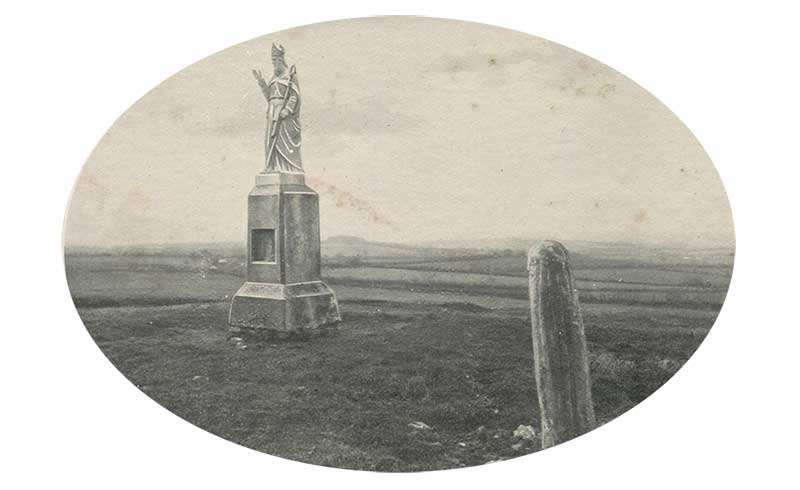The history of the Hill of Tara
HISTORY OF TARA HILL
Of the colonists that came to stay in the land, the Firbolgs were the earliest; and the bards tell us that Slainge, the first high king of that race, chose Tara Hill as the site of his royal palace,[1] and called it Druim Caein or the Beautiful Hill. If we can trust the chronology of the Four Masters, Slainge was contemporary with Abraham in the Land of Canaan; so that we must go back some nineteen hundred years before the Christian era for the first dun that crowned the Hill of Tara. I do not ask you to believe this. I merely quote the statement; and it is probably as well founded as a good deal of what is set down as ancient history. O’Flaherty’s chronology, however, which fixes the advent of the Firbolgs about the year 1250 B.C. is far more probable.
It is, however, to the second colony that occupied Ireland —the Tuatha de Danaan—that the origin of the Royal City of Tara is more commonly traced. Nine kings of the Firbolgs, it is said, ruled the land; but as they reigned in all only thirty-seven years, they could not have done much for Tara. It was the new colony—a more civilised and powerful people—who brought the Ogham lore to Erin and the Lia Fail to Tara, which they made—so the bardic story tells us—their Cathair, or capital city. Stone buildings were certainly not abundant at Tara, but still as it is called a Cathair by the poet Kineth O’Hartigan in the tenth century, we need not hesitate to adopt the term.
Tara was called Cathair Crofinn even before it was called Tara; and Crofinn is said to have been a queen of the Tuatha de Danaan, remarkable both for her talents and her beauty. Doubtless she was buried within the precincts of the Royal Rath, to which she gave her name; that is, if she did not, like many others of her people, take up her abode in the Land of Youth, either under the grassy slopes of Tara, or some other of the beautiful enchanted hills of Erin.
They were a strange people, these Tuatha de Danaan, dark-eyed and brown-haired, of unknown origin, but of much culture, ingenuity, and weird mysterious power, who left no survivors in the land of Erin, at least, amongst the children of mortal men. Would they had not vanished so completely, for the bardic story that tells of their advent and departure is full of a strange subtle interest which takes and keeps the mind by a secret, silent influence that cannot be measured or analysed. It pervades alike our history and our romance, the tales of our childhood, and the wanderings of our maturer fancy in mystic realms of a fairyland that is not all a fable.
It was the Tuatha de Danaan who brought to Tara that wonderful Lia Fail, the Stone of Destiny, of which you all have heard something. Some say it is still in Tara, others that it is under the Coronation Chair in Westminster Abbey. I shall speak of it presently, but it is quite natural that the enchanted stone should be the gift of the enchanted people; and its history—part fact and part fable—is as strange and mysterious as their own.

Tara - showing St. Patrick’s Statue and the Croppies’ Stone
So when the Milesian colony came to Erin, Tara, though not yet called by that name, was already the chief royal seat of the monarchy. Heremon was married to his cousin, a beautiful and accomplished princess named Tea, and she asked her lord, even before they landed, to give her as her dower her choice hill in Erin, “that she might be interred therein, and that her mound and grave-stone might be raised thereon,” and “where every prince to be born of her race should dwell for ever.” This favour was guaranteed to her; and then we are told that she chose Druim Caein, called also Laeth-Druim, the Beautiful Hill, which from her is called Tea-Muir, i.e., Tara, the Mound of Tea, and therein she was interred. The Irish form was Tea-muir, latinized Temora, which by a kind of metathesis has become Tara in the genitive case. Other explanations of the name have been also given; but this is at once the most ancient, the most natural, and the most poetic. The pillar stone still standing on Tara Hill, over the Croppies’ grave, which Petrie thinks was the original Lia Fail, was in my opinion the gravestone raised over Tea’s monument more than three thousand years ago. We know that such monumental pillars, “hoary inscrutable sentinels of the past,” were raised elsewhere over royal graves, as at Rathcroghan over the grave of King Dathi, and at Roscam, near Galway, over the grave of King Brian, the great ancestor of the Connaught kings; and in some cases they came to be worshipped as idols. So Tea’s pillar-stone was raised at Tara over her mur or grave mound, from which it was removed after 1798, but only a few paces, to place it over the Croppies’ grave, where the foolish insurgent youths made their last vain stand for their country. There it has stood through all the changeful centuries, and the ashes of Tea’s offspring, who died for the land she loved, now rest in peace beneath its shadow.
Notes
[1] Poem ascribed to Caoilte MacRonain.
